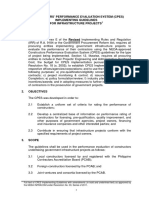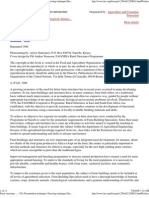Tutorial Chapter 2
Uploaded by
fatthul hadiTutorial Chapter 2
Uploaded by
fatthul hadiTutorial : chapter 2
6/3/2014
PARTICLE DIAMETER
1. Calculate the equivalent volume sphere diameter d v and the surface volume
equivalent sphere, dsv of a cuboid particle of side length 1, 2 and 4 mm. (ans:
dv = 2.481mm, dsv = 1.714mm)
2. Particle (density=2000kg/m3) with sphericity of 0.9 are poured into a
container. A sample of 2000 particles taken from the powder weighed 1000
mg. Determine volume diameter and surface/volume diameter. (ans: d v =
7.816 x 10-4 m , dsv = 7.034 x 10-4 m )
3. For a regular cuboid particle of dimensions 1.00 x 2.00 x 6.00 mm, calculate
the following diameters:
a. The equivalent volume sphere diameter
b. The equivalent surface sphere diameter
c. The surface/volume diameter
d. The sieve diameter ( the width of minimum aperture through which the
particle will pass)
e. The projected area diameters ( the diameter of a circle having the
same area as the projected area of the particle resting in a stable
position)
(ans: (a) 2.84mm; (b) 3.57mm; (c) 1.80mm; (d) 2.00 mm; (e) 2.76mm,
1.6mm, 3.91mm)
4. For a regular cylinder particle of diameter 0.100 mm and length 1.00mm,
calculate the following diameters:
a. The equivalent volume sphere diameter
b. The equivalent surface sphere diameter
c. The surface/volume diameter
d. The sieve diameter ( the width of minimum aperture through which the
particle will pass)
e. The projected area diameters ( the diameter of a circle having the
same area as the projected area of the particle resting in a stable
position)
(ans: (a) 0.247mm; (b) 0.324mm; (c) 0.142mm; (d) 0.10mm;
(e)0.10mm, 0.357)
You might also like
- Automatic Control Kuo Solution Manual 10th100% (4)Automatic Control Kuo Solution Manual 10th978 pages
- A Not So Comprehensive Recalled Questions PDFNo ratings yetA Not So Comprehensive Recalled Questions PDF7 pages
- TOPIC 1: Vision, Mission, Goals and Objectives: Abe 510: Agricultural Products Process EngineeringNo ratings yetTOPIC 1: Vision, Mission, Goals and Objectives: Abe 510: Agricultural Products Process Engineering4 pages
- Soil and Water Conservation Engineering, Irrigation and Drainage and Allied Subjects August 26, 2015 8am-1pmNo ratings yetSoil and Water Conservation Engineering, Irrigation and Drainage and Allied Subjects August 26, 2015 8am-1pm2 pages
- 15 Determine Moisture of Seed Learner ManualNo ratings yet15 Determine Moisture of Seed Learner Manual23 pages
- QA in ABE Laws Engr. Arthur It. Tambong FPSAENo ratings yetQA in ABE Laws Engr. Arthur It. Tambong FPSAE3 pages
- Recalled Board Examinations 2018 Engr. Rey V. TompongNo ratings yetRecalled Board Examinations 2018 Engr. Rey V. Tompong4 pages
- ABE 54 Lab Exercise 2 RLC Circuit AnalysisNo ratings yetABE 54 Lab Exercise 2 RLC Circuit Analysis8 pages
- PNS BAFS PAES 217-2017 - Determination of Irrigation Water RequirementsNo ratings yetPNS BAFS PAES 217-2017 - Determination of Irrigation Water Requirements54 pages
- Philippine Agricultural Engineering Standards100% (1)Philippine Agricultural Engineering Standards5 pages
- Agricultural & Biosystems Engineers 09-2021No ratings yetAgricultural & Biosystems Engineers 09-202163 pages
- Lecture 2 - Physical Properties of AB MaterialsNo ratings yetLecture 2 - Physical Properties of AB Materials40 pages
- AE 152 - Irrigation and Drainage Engineering - Syllabus100% (1)AE 152 - Irrigation and Drainage Engineering - Syllabus11 pages
- Registered Professional Agricultural Engineer (RPAE) - Every Person Admitted To The PracticeNo ratings yetRegistered Professional Agricultural Engineer (RPAE) - Every Person Admitted To The Practice3 pages
- Competency Agricultural Machinery Design, Fabrication/ Manufacturing and TestingNo ratings yetCompetency Agricultural Machinery Design, Fabrication/ Manufacturing and Testing23 pages
- Agricultural Engineering Board Exam Recalled Questions 2010No ratings yetAgricultural Engineering Board Exam Recalled Questions 201010 pages
- Farm Structures in Tropical Climates - Ch1No ratings yetFarm Structures in Tropical Climates - Ch111 pages
- 4701-Article Text-Importance of Biology For EngineersNo ratings yet4701-Article Text-Importance of Biology For Engineers5 pages
- Design of Agricutural Tractor and Machinery - Practice Set 1100% (1)Design of Agricutural Tractor and Machinery - Practice Set 14 pages
- Agri Engineering Profession Roadmap PresentationNo ratings yetAgri Engineering Profession Roadmap Presentation24 pages
- Live Your Life. Create Your Destiny.: Department of Chemical, Metallurgical & Materials Engineering100% (1)Live Your Life. Create Your Destiny.: Department of Chemical, Metallurgical & Materials Engineering17 pages
- This Pictured Show The Radius of The Blast of Accident Happened - Damage About To 50-70 Homes and 50-70 Unit Apartment StoreNo ratings yetThis Pictured Show The Radius of The Blast of Accident Happened - Damage About To 50-70 Homes and 50-70 Unit Apartment Store4 pages
- Design Evaluation of Particulate Wet Scrubbing SystemsNo ratings yetDesign Evaluation of Particulate Wet Scrubbing Systems11 pages
- Gantt Chart: Approved by Encik Muzani Malek Review by Encik Aizat Prepared by Ahmad Fatthul Hadi ActualNo ratings yetGantt Chart: Approved by Encik Muzani Malek Review by Encik Aizat Prepared by Ahmad Fatthul Hadi Actual1 page
- Scaling Factors A 10% / 10mm B 1h/ 2000mm 3600s / 2000mmNo ratings yetScaling Factors A 10% / 10mm B 1h/ 2000mm 3600s / 2000mm2 pages
- Chapter 1: Fundamentals Laws: Prepared By: Lim Ying Pei FKK, Uitm Shah AlamNo ratings yetChapter 1: Fundamentals Laws: Prepared By: Lim Ying Pei FKK, Uitm Shah Alam15 pages
- Chapter 1: Fundamentals Laws: Prepared By: Lim Ying Pei FKK, Uitm Shah AlamNo ratings yetChapter 1: Fundamentals Laws: Prepared By: Lim Ying Pei FKK, Uitm Shah Alam15 pages
- Chapter 2 Particle Size CharacterizationNo ratings yetChapter 2 Particle Size Characterization45 pages
- Chapter 2 Particle Size CharacterizationNo ratings yetChapter 2 Particle Size Characterization45 pages
- Catamisan, Andrew Jozsef D. Phy11l A4 E201 3q1617No ratings yetCatamisan, Andrew Jozsef D. Phy11l A4 E201 3q16172 pages
- MCQ On Cables - 1 - How Engineering WorksNo ratings yetMCQ On Cables - 1 - How Engineering Works3 pages
- Electric Dipole Induced Spin Resonance in Quantum DotsNo ratings yetElectric Dipole Induced Spin Resonance in Quantum Dots11 pages
- Chemical Process Modeling and SimulationNo ratings yetChemical Process Modeling and Simulation3 pages
- 3) Figure Given Below Shows The Dimension Obtained On A Component by A Certain InstrumentNo ratings yet3) Figure Given Below Shows The Dimension Obtained On A Component by A Certain Instrument15 pages
- Chapter Two, The Structure of Crystalline Solids PDFNo ratings yetChapter Two, The Structure of Crystalline Solids PDF23 pages
- International Journal of Pharmaceutics 568 (2019) 118522No ratings yetInternational Journal of Pharmaceutics 568 (2019) 11852214 pages
- MATLAB Implementation of Memristor Based Chua S Circuit and Its Chaos ControlNo ratings yetMATLAB Implementation of Memristor Based Chua S Circuit and Its Chaos Control9 pages
- Characteristic and Performance of Power Transmission LineNo ratings yetCharacteristic and Performance of Power Transmission Line15 pages
- 2023 ACH260S AtomicSpec Chapter6 X-Ray TechniquesNo ratings yet2023 ACH260S AtomicSpec Chapter6 X-Ray Techniques42 pages
- Test Planner - Phase-01 For CF OYM - AY-2024-2025 Version 1.0No ratings yetTest Planner - Phase-01 For CF OYM - AY-2024-2025 Version 1.02 pages
- Fire Dynamics Simulator (Version 5) Technical Reference GuideNo ratings yetFire Dynamics Simulator (Version 5) Technical Reference Guide110 pages




































































































